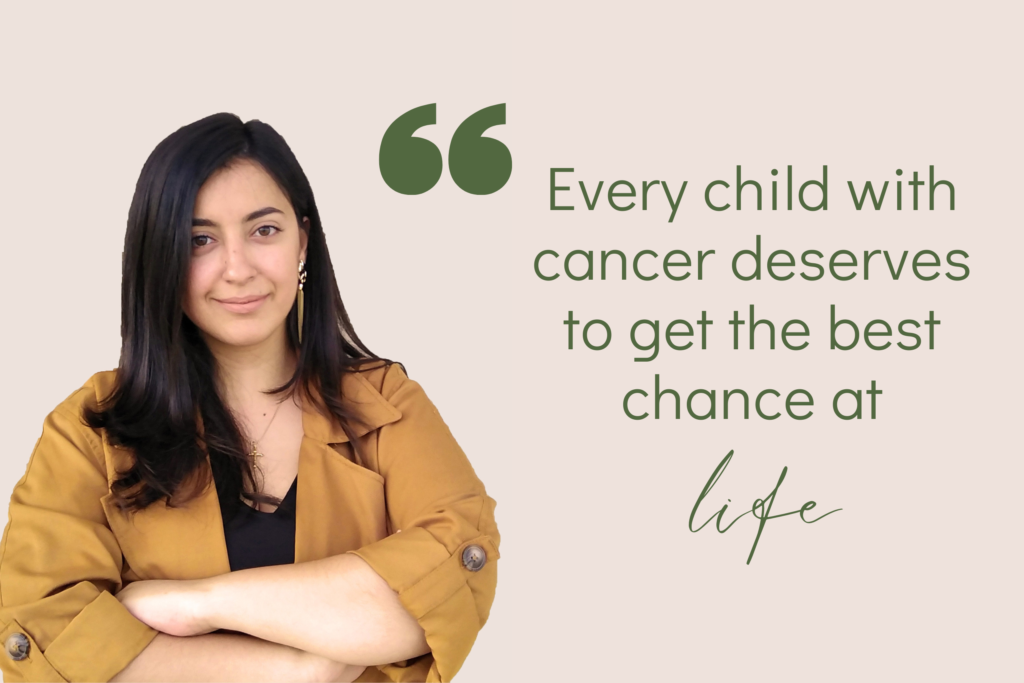September is Childhood cancer awareness month and is symbolised by a gold ribbon, a color of strength, courage, and resiliency!
Cancer is a major cause of death in children worldwide (1). That’s why it’s very important to focus on raising awareness about childhood cancer and the issues that patients, their families, and survivors face.

What is Childhood Cancer ?
Cancer in children can occur anywhere in the body.
The most common types of cancers diagnosed in children (0-14 years) are (2):
- Leukemia, a type of blood cancer;
- Brain and Spinal Cord tumors;
- Lymphoma, a cancer of the lymphatic system.
There are differences between cancers in adult and children, in terms of the types of cancers that children tend to get, how they are treated and how they respond to treatment.
Childhood Cancer in Numbers
In 2020 almost 280 000 children and adolescents (aged 0–19 years) were diagnosed with cancer worldwide and almost 110 000 children died from cancer (3). It’s important to note that these numbers may be higher, because in many countries childhood cancer is difficult to diagnose.
As for the survival rates, more than 80% of children with cancer are cured in high-income countries, but on the other hand, less than 30% are cured in low- and middle-income countries (LMICs) (4).
Childhood Cancer Inequalities
The survival rate in high-income countries have increased in the past few decades due to improved diagnosis and treatment and the use of innovative technologies. But unfortunately this is not the case in LMICs, where survival rates are much lower.
This difference in survival rates is caused by:
- Delayed or inaccurate diagnosis;
- Inaccessible therapy: lack of of medicines and pediatric facilities;
- Abandonment of treatment;
- Death from toxicity (side effects);
- Avoidable relapse.
Therefore, it’s very important to work on reducing that gap by raising more awareness about childhood cancer and improving access to childhood cancer care because every child with cancer deserves to get the best chance at life.

What Causes Cancer in Children?
The etiology or the cause of cancer in children remains largely unknown. Many different factors have been associated with childhood cancer, with varying degrees of certainty.
The following are risk factors known to be associated with childhood cancer:
- Some genetic disorders (ataxia-telangiectasia, Wiskott Aldrich syndrome and others)
- Immunodeficiency disorders including acquired immunodeficiency syndrome (AIDS)/ human immunodeficiency virus (HIV) infections.
- Family history of cancer.
- Exposures to certain viruses, such as the Epstein-Barr virus (EBV), have been associated to an increased risk of developing certain childhood cancers such as Hodgkin and non-Hodgkin lymphoma.
On the other hand, there are several factors related to pregnancy and first months of life suspected to be associated with childhood cancer:
- Before pregnancy, using fertility treatment is suspected to be a risk factor while folic acid supplementation before and during pregnancy is suspected to be a protective factor against childhood cancer.
- Some maternal behavioral factors during pregnancy, including alcohol, coffee and cigarette consumption are suspected to increase the risk of some childhood cancers.
- Other environmental exposures suspected to be associated with childhood cancer are maternal exposure to ionizing radiation and to pesticides, either occupationally or at home.
- Breastfeeding (BF) in early life, may have a protective effect against childhood cancer because breast milk contains antibodies that can strengthens the immune system, control cell proliferation and shape the gut microbiota.
These factors are modifiable, that’s why it’s very important to raise more awareness among women of childbearing age about the risks of environmental exposures and some maternal consumptions during pregnancy and invite them to follow the recommendations of the World Health Organization (WHO) recommending daily supplementation with 400 μg of folic acid for women before and during pregnancy and exclusive BF for the first 6 months and continuous BF up to 24 months of age or beyond.
Childhood Cancer Survivors: Long Term Cancer Treatment Effects
Many childhood cancer survivors are at risk of developing treatment-related health issues later in life including cardiovascular disease, psychosocial and cognitive problems, metabolic issues like obesity particularly linked to cranial radiotherapy.
Therefore, it’s very important that cancer survivors take care of their health and continue to receive follow-up care.
On the other hand, more research is needed to understand more the long-term effects of treatment and help develop new therapies to minimize those effects.
Bottom Line
More research is needed to understand the causes of childhood cancer. Raising awareness about childhood cancer is important, especially that some suspected protective and risk factors are modifiable and amenable to change. Also efforts should me made to reduce inequalities and improve access to healthcare.
And finally a message for you, our warriors who are fighting cancer:
” You are BRAVE, you are STRONG, you are LOVED and you are our INSPIRATION. Keep fighting 💪🏻”

